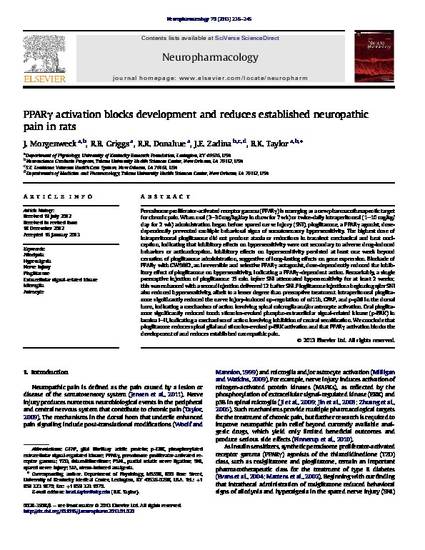
Article
PPARg activation blocks development and reduces established neuropathic pain in rats
Neuropharmacology
(2013)
Abstract
Peroxisomeproliferator-activated receptor gamma (PPARg) isemerging as a newpharmacotherapeutic target for chronic pain.When oral (3e30 mg/kg/day in chowfor 7 wk) or twice-daily intraperitoneal (1e10 mg/kg/ day for 2 wk) administration began before spared nerve injury (SNI), pioglitazone, a PPARg agonist, dosedependently prevented multiple behavioral signs of somatosensory hypersensitivity. The highest dose of intraperitoneal pioglitazone did not produce ataxia or reductions in transient mechanical and heat nociception, indicating that inhibitory effects on hypersensitivity were not secondary to adverse drug-induced behaviors or antinociception. Inhibitory effects on hypersensitivity persisted at least one week beyond cessation of pioglitazone administration, suggestive of long-lasting effects on gene expression. Blockade of PPARg with GW9662, an irreversible and selective PPARg antagonist, dose-dependently reduced the inhibitory effect of pioglitazone on hypersensitivity, indicating a PPARg-dependent action. Remarkably, a single preemptive injection of pioglitazone 15 min before SNI attenuated hypersensitivity for at least 2 weeks; thiswas enhanced with a second injection delivered 12 h after SNI. Pioglitazone injections beginning after SNI also reduced hypersensitivity, albeit to a lesser degree than preemptive treatment. Intraperitoneal pioglitazone significantly reduced the nerve injury-induced up-regulation of cd11b, GFAP, and p-p38 in the dorsal horn, indicating a mechanism of action involving spinal microglia and/or astrocyte activation. Oral pioglitazone significantly reduced touch stimulus-evoked phospho-extracellular signal-related kinase (p-ERK) in lamina IeII, indicating a mechanism of action involving inhibition of central sensitization.We conclude that pioglitazone reduces spinal glial and stimulus-evoked p-ERK activation and that PPARg activation blocks the development of and reduces established neuropathic pain.
Keywords
- allodynia,
- hyperalgesia,
- nerve injury,
- pioglitazone,
- extracellular signal-regulated kinase,
- microglia,
- astrocyte
Disciplines
Publication Date
2013
Citation Information
Jenny Morgenweck, Ryan B Griggs, Renee R. Donahue, James E Zadina, et al.. "PPARg activation blocks development and reduces established neuropathic pain in rats" Neuropharmacology Vol. 70 (2013) Available at: http://works.bepress.com/renee_donahue/7/
